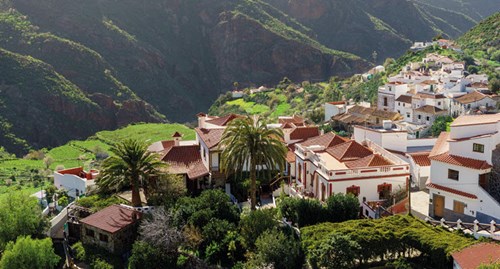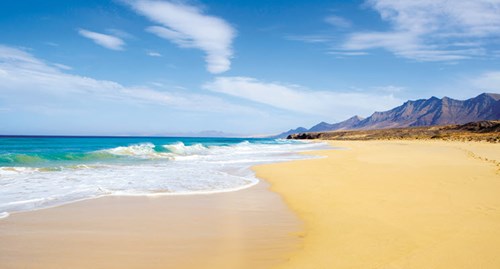
The Canaries are a firm family favourite - easy to reach, affordable, diverse and with year-long sun. But which one should you choose? We've asked two local experts for their top 5 reasons for choosing Gran Canaria or Fuerteventura. Find out what writer Mark Stanley and John Goldacre of Goldacre Estates had to say.
Gran Canaria
1) Unbeatable for beaches
Often described as one big beach, Fuerteventura lays claim to having the best beaches not just in Spain but in Europe. Long stretches of spectacular golden sand sloping down to a rippling turquoise sea is the norm here. In contrast to the bar-lined promenades that typify other Canaries, many of the island’s 152 beaches are within protected areas or flanked by dunes. Particular gems include those around Corralejo in the north, Sotavento, Costa Calma and Cofete in the south and the centrally located Caleta de Fuste.
2) Mesmerising natural landscape
Despite being one of the oldest of the Canary Islands, Fuerteventura is arguably the best preserved. A Unesco biosphere reserve, it boasts 13 protected areas spread among its rolling volcanic landscape and sandy coastline. Highlights include the Tindaya mountain, Isla de Lobos, the old town of Betancuria, Corralejo’s sand dunes and the southern Jandía peninsula, made up of 15,000 hectares of virginal lunarscape. Goats and aloe vera plantations are also integral to its landscape. The island’s handful of small resortsare concentrated along its eastern shore, while the wilder west coast, largely untouched by humans, offers more than 100 km of cliffs and deserted beaches.
3) Fabulous for foodies
Unlike Fuerteventura, Gran Canaria is spoilt for choice with fine eateries offering astonishing views. Meloneras in the south or Triana and Mercado del Puerto in Las Palmas are fabulous. Amit Chellaram, a resident and retail property professional, recommends Calle Olof Palme in Las Palmas: try Carlichi for cocktails, Rio Miño for seafood and El Churrasco for meat. Lagarto Iberico is the juciest pork you’ll ever taste, complemented by roasted peppers and seawater-boiled papas arrugadas. Gran Canaria grows Arabica coff ee, so ask for a Canary Island speciality: Barraquito coffee. It consists of coffee, sugar, alcohol, cream, lemon and cinnamon and is delicious.

4) Property that keeps its value
In 2007/8, Gran Canaria properties lost 30 per cent of their value compared with 50 per cent on Lanzarote, reports the agent Luis Elías of Remax. The beaches in Las Palmas and the breathtaking dunes connecting Playa del Ingles, Maspalomas and the upmarket Meloneras mean property prices in these regions recover fast. A sizeable population, long vacations by Nordic snowbirds and restricted land mean there is a sustainable demand solidly supporting a price fl oor. Las Palmas has the second highest rental yields in Spain and Meloneras has a big appeal too, with two-bedroom duplexes starting at €300,000 and their rental commanding in the region of €1,900 per month.
5) A walk on the wild side
Kite-boarding is a speciality in Fuerteventura and Lanzarote has cycling. Yet Gran Canaria does it all, says Paola Buscemi of CancoTravel Services, with canyoning, skydiving, hiking, quad biking, surfi ng, fi shing and cycling on off er. Forced to pick one, though, it would be hiking. Half an hour from Maspalomas you’re on the Fataga trail, surrounded by buzzards, rainbow skink and mountains. Head north and trek the Tamadaba forest or climb the mystical Roque Nublo. Almond blossoms add a beauty and a mellifluous sweet scent to the air from January to March. It is hugely underrated as a walking destination meaning that you can enjoy peaks and palm-filled valleys far from the madding crowd.
Download our free guide to buying a property in Spain
Fuerteventura
1) Unbeatable for beaches
Often described as one big beach, Fuerteventura lays claim to having the best beaches not just in Spain but in Europe. Long stretches of spectacular golden sand sloping down to a rippling turquoise sea is the norm here. In contrast to the bar-lined promenades that typify other Canaries, many of the island’s 152 beaches are within protected areas or flanked by dunes. Particular gems include those around Corralejo in the north, Sotavento, Costa Calma and Cofete in the south and the centrally located Caleta de Fuste.
2) Mesmerising natural landscape
Despite being one of the oldest of the Canary Islands, Fuerteventura is arguably the best preserved. A Unesco biosphere reserve, it boasts 13 protected areas spread among its rolling volcanic landscape and sandy coastline. Highlights include the Tindaya mountain, Isla de Lobos, the old town of Betancuria, Corralejo’s sand dunes and the southern Jandía peninsula, made up of 15,000 hectares of virginal lunarscape. Goats and aloe vera plantations are also integral to its landscape. The island’s handful of small resorts are concentrated along its eastern shore, while the wilder west coast, largely untouched by humans, offers more than 100 km of cliffs and deserted beaches.

3) Refreshingly underdeveloped
One of the least populated islands but the second largest after Tenerife, Fuerteventura is considered the “virgin island” and as a result is less crowded and benefits from more open spaces. The majority of buyers choose the northern municipality of La Oliva which has access to Europe’s best beaches and a coastline dotted with traditional villages offering great cuisine. One to two-bed apartments are popular in towns, with larger chalets a little inland. Key resorts in the north are Corralejo and El Cotillo, which are popular for their cosmopolitan lifestyle. Caleta de Fuste and the central part of the island are very close to the airport and offer golf courses, resort areas, shopping and resort hotel facilities. Jandía and Costa Calma are favoured for their sheltered golden sandy beaches, beach boulevard and shopping.
4) Cheaper, lettable property
Comparing property per square metre, Fuerteventura is regarded as the most reasonable. The generally lower, less mountainous terrain makes for cheaper building costs. Being the last of the main islands to be developed and with a smaller – although growing – tourist trade has meant that real estate prices have been much better value and are now starting to rise. Thanks to the year-round sunshine and good air links with the UK and Europe, the island isn’t particularly seasonal, which in turn makes for a good holiday-let market.
5) Watersports heaven
Ideal conditions have made the island an internationally acclaimed destination for surface watersports. Complementing the year-round sunshine and the warm sea is a consistent wind that averages 13mph: there’s a reason the island is dotted with windmills and its name means “strong wind”. The south-east around Sotavento is the best stretch for windsurfing and kitesurfing, hence the world championships are held there every year. Meanwhile, surfers in search of Atlantic rollers tend to head to the northwest. Also on offer is diving, snorkelling, sailing, paddleboarding and some of Europe’s best deep-sea fishing.
You may also like:
